The Cambridge History of Japan, Vol. 4: Early Modern Japan
Подождите немного. Документ загружается.

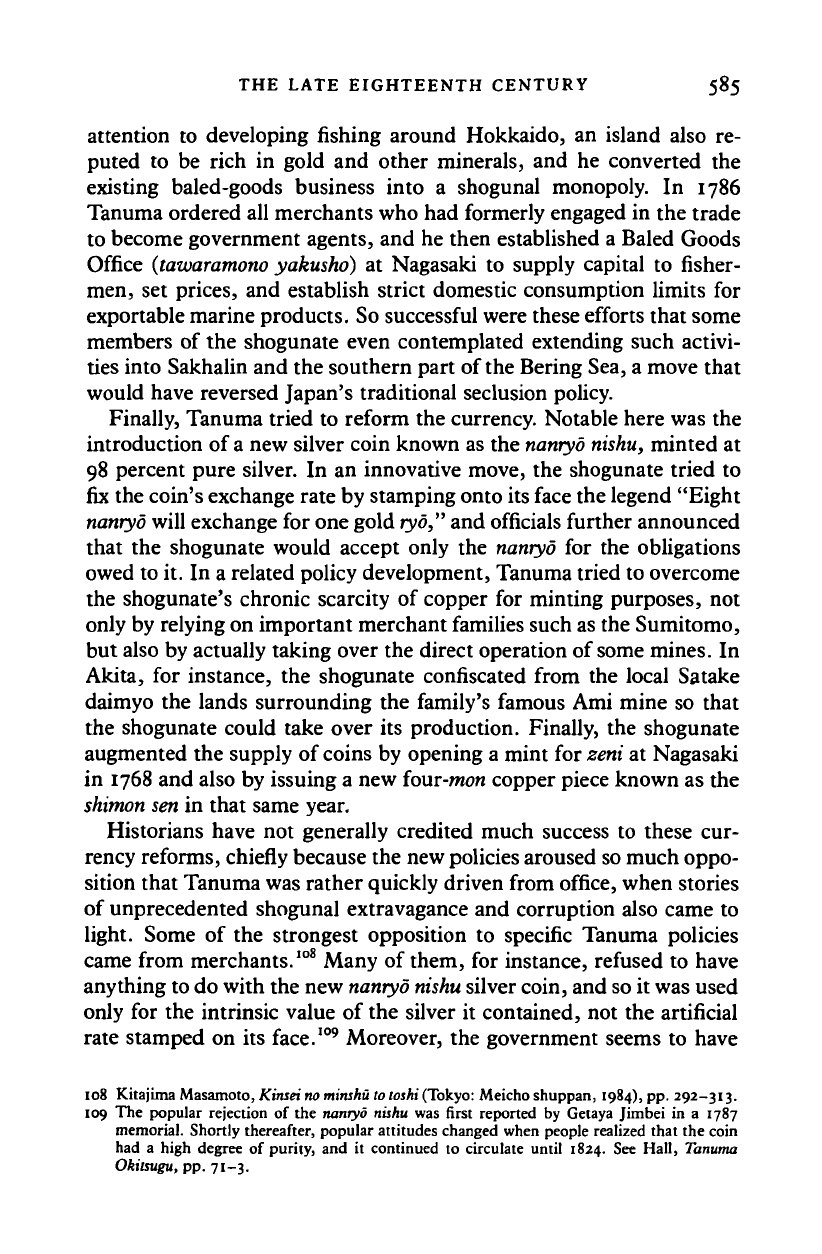
THE LATE EIGHTEENTH CENTURY 585
attention to developing fishing around Hokkaido, an island also re-
puted to be rich in gold and other minerals, and he converted the
existing baled-goods business into a shogunal monopoly. In 1786
Tanuma ordered all merchants who had formerly engaged in the trade
to become government agents, and he then established a Baled Goods
Office
(tawaramono yakusho)
at Nagasaki to supply capital to fisher-
men, set prices, and establish strict domestic consumption limits for
exportable marine products. So successful were these efforts that some
members of the shogunate even contemplated extending such activi-
ties into Sakhalin and the southern part of the Bering Sea, a move that
would have reversed Japan's traditional seclusion policy.
Finally, Tanuma tried to reform the currency. Notable here was the
introduction of
a
new silver coin known as the
nanryo
nishu,
minted at
98 percent pure silver. In an innovative move, the shogunate tried to
fix the coin's exchange rate by stamping onto its face the legend "Eight
nanryo
will exchange for one gold
ryo,"
and officials further announced
that the shogunate would accept only the
nanryo
for the obligations
owed to it. In a related policy development, Tanuma tried to overcome
the shogunate's chronic scarcity of copper for minting purposes, not
only by relying on important merchant families such as the Sumitomo,
but also by actually taking over the direct operation of
some
mines. In
Akita, for instance, the shogunate confiscated from the local Satake
daimyo the lands surrounding the family's famous Ami mine so that
the shogunate could take over its production. Finally, the shogunate
augmented the supply of
coins
by opening a mint for
zeni
at Nagasaki
in 1768 and also by issuing a new four-won copper piece known as the
shimon sen
in that same year.
Historians have not generally credited much success to these cur-
rency reforms, chiefly because the new policies aroused so much oppo-
sition that Tanuma was rather quickly driven from office, when stories
of unprecedented shogunal extravagance and corruption also came to
light. Some of the strongest opposition to specific Tanuma policies
came from merchants.
1
"
8
Many of them, for instance, refused to have
anything to do with the new
nanryo nishu
silver coin, and so it was used
only for the intrinsic value of the silver it contained, not the artificial
rate stamped on its face.
109
Moreover, the government seems to have
108 Kitajima Masamoto, Kinsei
no minshu
to
toshi
(Tokyo:
Meicho shuppan, 1984), pp. 292-313.
109 The popular rejection of the nanryo nishu was first reported by Getaya Jimbei in a 1787
memorial. Shortly thereafter, popular attitudes changed when people realized that the coin
had a high degree of purity, and it continued to circulate until 1824. See Hall, Tanuma
Okitsugu, pp. 71-3.
Cambridge Histories Online © Cambridge University Press, 2008
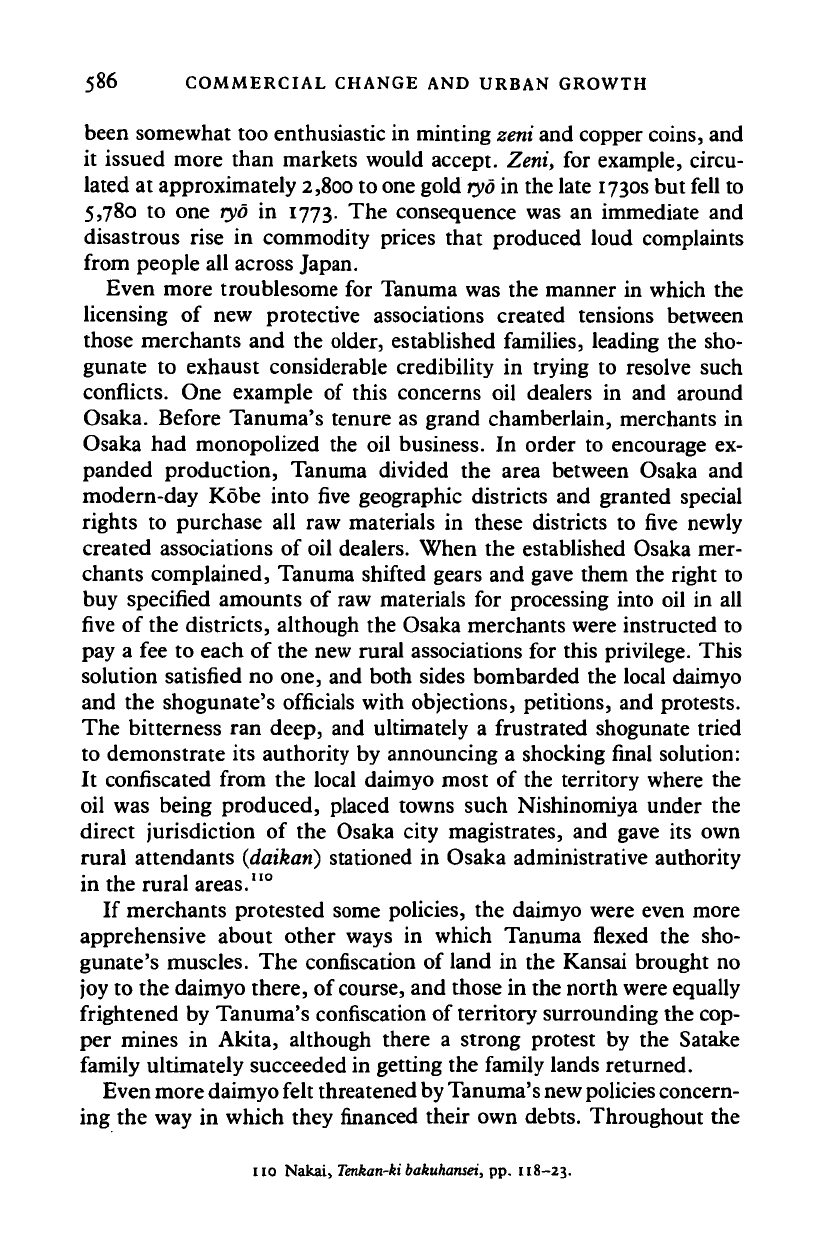
586 COMMERCIAL CHANGE AND URBAN GROWTH
been somewhat too enthusiastic in minting zeni and copper coins, and
it issued more than markets would accept. Zeni, for example, circu-
lated at approximately 2,800 to one gold
ryo
in the late 1730s but fell to
5,780
to one ryo in 1773. The consequence was an immediate and
disastrous rise in commodity prices that produced loud complaints
from people all across Japan.
Even more troublesome for Tanuma was the manner in which the
licensing of new protective associations created tensions between
those merchants and the older, established families, leading the sho-
gunate to exhaust considerable credibility in trying to resolve such
conflicts. One example of this concerns oil dealers in and around
Osaka. Before Tanuma's tenure as grand chamberlain, merchants in
Osaka had monopolized the oil business. In order to encourage ex-
panded production, Tanuma divided the area between Osaka and
modern-day Kobe into five geographic districts and granted special
rights to purchase all raw materials in these districts to five newly
created associations of oil dealers. When the established Osaka mer-
chants complained, Tanuma shifted gears and gave them the right to
buy specified amounts of raw materials for processing into oil in all
five of the districts, although the Osaka merchants were instructed to
pay a fee to each of the new rural associations for this privilege. This
solution satisfied no one, and both sides bombarded the local daimyo
and the shogunate's officials with objections, petitions, and protests.
The bitterness ran deep, and ultimately a frustrated shogunate tried
to demonstrate its authority by announcing a shocking final solution:
It confiscated from the local daimyo most of the territory where the
oil was being produced, placed towns such Nishinomiya under the
direct jurisdiction of the Osaka city magistrates, and gave its own
rural attendants {daikan) stationed in Osaka administrative authority
in the rural areas.
110
If merchants protested some policies, the daimyo were even more
apprehensive about other ways in which Tanuma flexed the sho-
gunate's muscles. The confiscation of land in the Kansai brought no
joy to the daimyo there, of course, and those in the north were equally
frightened by Tanuma's confiscation of territory surrounding the cop-
per mines in Akita, although there a strong protest by the Satake
family ultimately succeeded in getting the family lands returned.
Even more daimyo felt threatened
by
Tanuma's
new policies
concern-
ing the way in which they financed their own debts. Throughout the
no Nakai,
Tenkan-ki
bakuhansei, pp. 118-23.
Cambridge Histories Online © Cambridge University Press, 2008
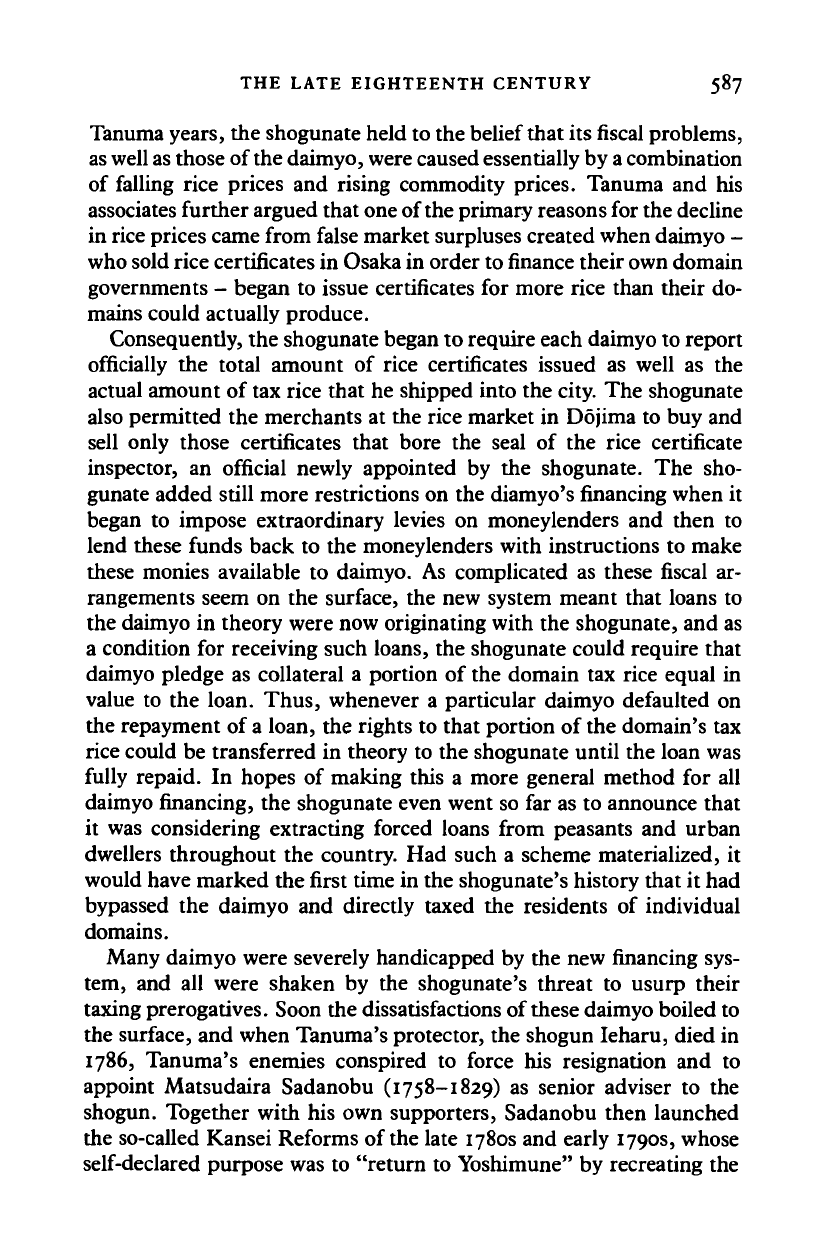
THE LATE EIGHTEENTH CENTURY 587
Tanuma years, the shogunate held to the belief that its
fiscal
problems,
as well as
those of the daimyo, were caused essentially by
a
combination
of falling rice prices and rising commodity prices. Tanuma and his
associates further argued that one of the primary reasons for the decline
in rice prices came from false market surpluses created when daimyo -
who sold rice certificates in Osaka in order to
finance
their own domain
governments - began to issue certificates for more rice than their do-
mains could actually produce.
Consequently, the shogunate began to require each daimyo to report
officially the total amount of rice certificates issued as well as the
actual amount of tax rice that he shipped into the city. The shogunate
also permitted the merchants at the rice market in Dojima to buy and
sell only those certificates that bore the seal of the rice certificate
inspector, an official newly appointed by the shogunate. The sho-
gunate added still more restrictions on the diamyo's financing when it
began to impose extraordinary levies on moneylenders and then to
lend these funds back to the moneylenders with instructions to make
these monies available to daimyo. As complicated as these fiscal ar-
rangements seem on the surface, the new system meant that loans to
the daimyo in theory were now originating with the shogunate, and as
a condition for receiving such loans, the shogunate could require that
daimyo pledge as collateral a portion of the domain tax rice equal in
value to the loan. Thus, whenever a particular daimyo defaulted on
the repayment of
a
loan, the rights to that portion of the domain's tax
rice could be transferred in theory to the shogunate until the loan was
fully repaid. In hopes of making this a more general method for all
daimyo financing, the shogunate even went so far as to announce that
it was considering extracting forced loans from peasants and urban
dwellers throughout the country. Had such a scheme materialized, it
would have marked the first time in the shogunate's history that it had
bypassed the daimyo and directly taxed the residents of individual
domains.
Many daimyo were severely handicapped by the new financing sys-
tem, and all were shaken by the shogunate's threat to usurp their
taxing prerogatives. Soon the dissatisfactions of these daimyo boiled to
the surface, and when Tanuma's protector, the shogun Ieharu, died in
1786,
Tanuma's enemies conspired to force his resignation and to
appoint Matsudaira Sadanobu (1758-1829) as senior adviser to the
shogun. Together with his own supporters, Sadanobu then launched
the so-called Kansei Reforms of the late 1780s and early 1790s, whose
self-declared purpose was to "return to Yoshimune" by recreating the
Cambridge Histories Online © Cambridge University Press, 2008
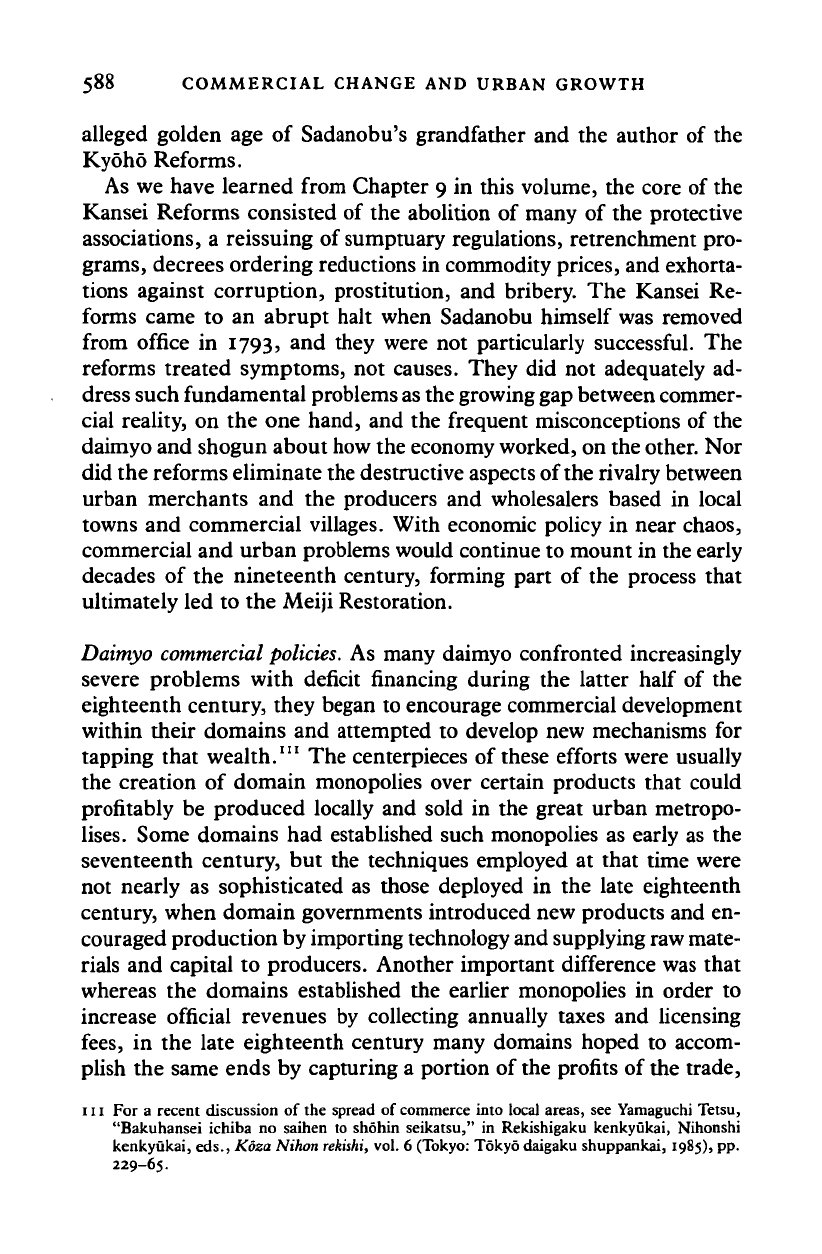
588 COMMERCIAL CHANGE AND URBAN GROWTH
alleged golden age of Sadanobu's grandfather and the author of the
Kyoho Reforms.
As we have learned from Chapter 9 in this volume, the core of the
Kansei Reforms consisted of the abolition of many of the protective
associations, a reissuing of sumptuary regulations, retrenchment pro-
grams, decrees ordering reductions in commodity prices, and exhorta-
tions against corruption, prostitution, and bribery. The Kansei Re-
forms came to an abrupt halt when Sadanobu himself was removed
from office in 1793, and they were not particularly successful. The
reforms treated symptoms, not causes. They did not adequately ad-
dress such fundamental problems
as
the growing
gap
between commer-
cial reality, on the one hand, and the frequent misconceptions of the
daimyo and shogun about how the economy worked, on the other. Nor
did the reforms eliminate the destructive aspects of the rivalry between
urban merchants and the producers and wholesalers based in local
towns and commercial villages. With economic policy in near chaos,
commercial and urban problems would continue to mount in the early
decades of the nineteenth century, forming part of the process that
ultimately led to the Meiji Restoration.
Daimyo
commercial
policies.
As many daimyo confronted increasingly
severe problems with deficit financing during the latter half of the
eighteenth century, they began to encourage commercial development
within their domains and attempted to develop new mechanisms for
tapping that wealth.
111
The centerpieces of these efforts were usually
the creation of domain monopolies over certain products that could
profitably be produced locally and sold in the great urban metropo-
lises.
Some domains had established such monopolies as early as the
seventeenth century, but the techniques employed at that time were
not nearly as sophisticated as those deployed in the late eighteenth
century, when domain governments introduced new products and en-
couraged production by importing technology and supplying raw mate-
rials and capital to producers. Another important difference was that
whereas the domains established the earlier monopolies in order to
increase official revenues by collecting annually taxes and licensing
fees,
in the late eighteenth century many domains hoped to accom-
plish the same ends by capturing a portion of the profits of the trade,
in For a recent discussion of the spread of commerce into local areas, see Yamaguchi Tetsu,
"Bakuhansei ichiba no saihen to shohin seikatsu," in Rekishigaku kenkyukai, Nihonshi
kenkyukai, eds., Koza Nihon
rekishi,
vol. 6 (Tokyo: Tokyo daigaku shuppankai, 1985), pp.
229-65.
Cambridge Histories Online © Cambridge University Press, 2008
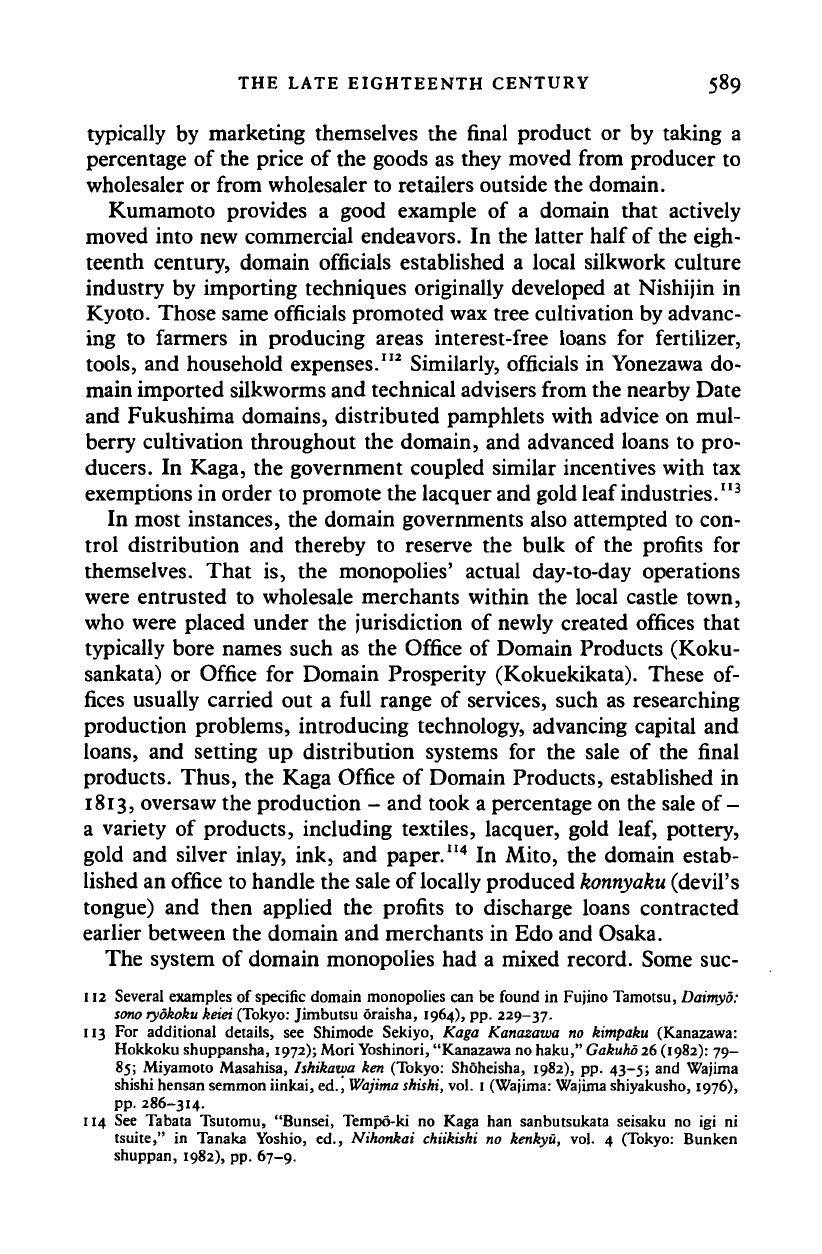
THE LATE EIGHTEENTH CENTURY 589
typically by marketing themselves the final product or by taking a
percentage of the price of the goods as they moved from producer to
wholesaler or from wholesaler to retailers outside the domain.
Kumamoto provides a good example of a domain that actively
moved into new commercial endeavors. In the latter half of the eigh-
teenth century, domain officials established a local silkwork culture
industry by importing techniques originally developed at Nishijin in
Kyoto. Those same officials promoted wax tree cultivation by advanc-
ing to farmers in producing areas interest-free loans for fertilizer,
tools,
and household expenses."
2
Similarly, officials in Yonezawa do-
main imported silkworms and technical advisers from the nearby Date
and Fukushima domains, distributed pamphlets with advice on mul-
berry cultivation throughout the domain, and advanced loans to pro-
ducers. In Kaga, the government coupled similar incentives with tax
exemptions in order to promote the lacquer and gold leaf industries."
3
In most instances, the domain governments also attempted to con-
trol distribution and thereby to reserve the bulk of the profits for
themselves. That is, the monopolies' actual day-to-day operations
were entrusted to wholesale merchants within the local castle town,
who were placed under the jurisdiction of newly created offices that
typically bore names such as the Office of Domain Products (Koku-
sankata) or Office for Domain Prosperity (Kokuekikata). These of-
fices usually carried out a full range of services, such as researching
production problems, introducing technology, advancing capital and
loans,
and setting up distribution systems for the sale of the final
products. Thus, the Kaga Office of Domain Products, established in
1813,
oversaw the production - and took a percentage on the sale of -
a variety of products, including textiles, lacquer, gold
leaf,
pottery,
gold and silver inlay, ink, and paper.
114
In Mito, the domain estab-
lished an office to handle the sale of locally produced
konnyaku
(devil's
tongue) and then applied the profits to discharge loans contracted
earlier between the domain and merchants in Edo and Osaka.
The system of domain monopolies had a mixed record. Some suc-
112 Several examples of specific domain monopolies can be found in Fujino Tamotsu, Daimyo:
sono ryokoku
keiei (Tokyo: Jimbutsu oraisha, 1964), pp. 229-37.
113 For additional details, see Shimode Sekiyo, Kaga Kanazawa no kimpaku (Kanazawa:
Hokkoku shuppansha, 1972); Mori Yoshinori, "Kanazawa no haku,"
Gakuho
26
(1982):
79-
85;
Miyamoto Masahisa, Ishikawa ken (Tokyo: Shoheisha, 1982), pp. 43-5; and Wajima
shishi hensan semmon iinkai, ed.',
Wajima
shishi,
vol. I (Wajima: Wajima shiyakusho, 1976),
pp.
286-314.
114 See Tabata Tsutomu, "Bunsei, Tempd-ki no Kaga han sanbutsukata seisaku no igi ni
tsuite," in Tanaka Yoshio, ed., Nihonkai chiikishi no kenkyu, vol. 4 (Tokyo: Bunken
shuppan, 1982), pp. 67-9.
Cambridge Histories Online © Cambridge University Press, 2008
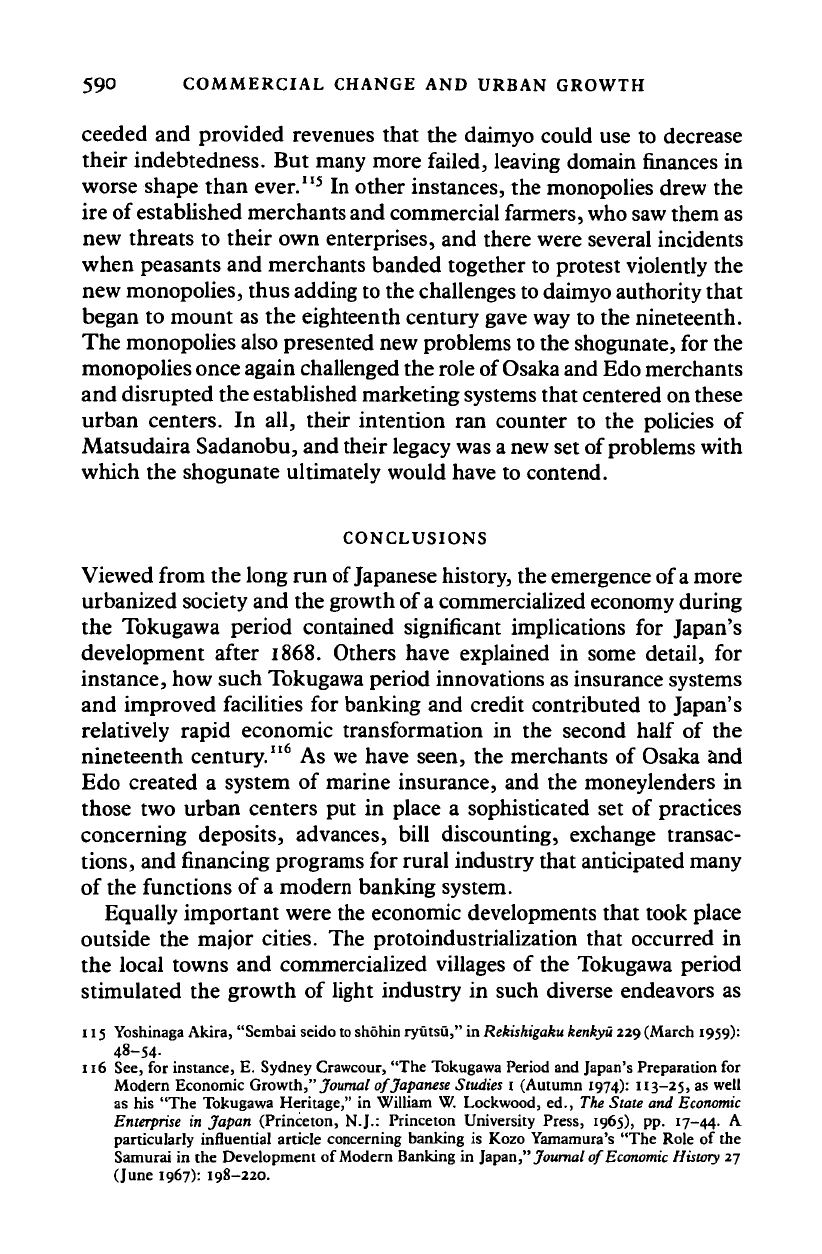
59° COMMERCIAL CHANGE AND URBAN GROWTH
ceeded and provided revenues that the daimyo could use to decrease
their indebtedness. But many more failed, leaving domain finances in
worse shape than ever.
1
'
5
In other instances, the monopolies drew the
ire of established merchants and commercial farmers, who saw them as
new threats to their own enterprises, and there were several incidents
when peasants and merchants banded together to protest violently the
new monopolies, thus adding to the challenges to daimyo authority that
began to mount as the eighteenth century gave way to the nineteenth.
The monopolies also presented new problems to the shogunate, for the
monopolies once again challenged the role of Osaka and Edo merchants
and disrupted the established marketing systems that centered on these
urban centers. In all, their intention ran counter to the policies of
Matsudaira Sadanobu, and their legacy was a new set of problems with
which the shogunate ultimately would have to contend.
CONCLUSIONS
Viewed from the long run of Japanese history, the emergence of a more
urbanized society and the growth of a commercialized economy during
the Tokugawa period contained significant implications for Japan's
development after 1868. Others have explained in some detail, for
instance, how such Tokugawa period innovations as insurance systems
and improved facilities for banking and credit contributed to Japan's
relatively rapid economic transformation in the second half of the
nineteenth century.
116
As we have seen, the merchants of Osaka and
Edo created a system of marine insurance, and the moneylenders in
those two urban centers put in place a sophisticated set of practices
concerning deposits, advances, bill discounting, exchange transac-
tions,
and financing programs for rural industry that anticipated many
of the functions of
a
modern banking system.
Equally important were the economic developments that took place
outside the major cities. The protoindustrialization that occurred in
the local towns and commercialized villages of the Tokugawa period
stimulated the growth of light industry in such diverse endeavors as
115 Yoshinaga Akira, "Sembai seido to shohin ryutsu," in
Rekishigaku kenkyu
229 (March 1959):
48-54.
116 See, for instance, E. Sydney Crawcour, "The Tokugawa Period and Japan's Preparation for
Modern Economic
Growth,"
Journal
of Japanese Studies 1 (Autumn 1974): 113-25, as well
as his "The Tokugawa Heritage," in William W. Lockwood, ed., The State and
Economic
Enterprise in Japan (Princeton, N.J.: Princeton University Press, 1965), pp. 17-44. A
particularly influential article concerning banking is Kozo Yamamura's "The Role of the
Samurai in the Development of Modern Banking in
Japan,"
Journal
of
Economic
History 27
(June 1967): 198-220.
Cambridge Histories Online © Cambridge University Press, 2008
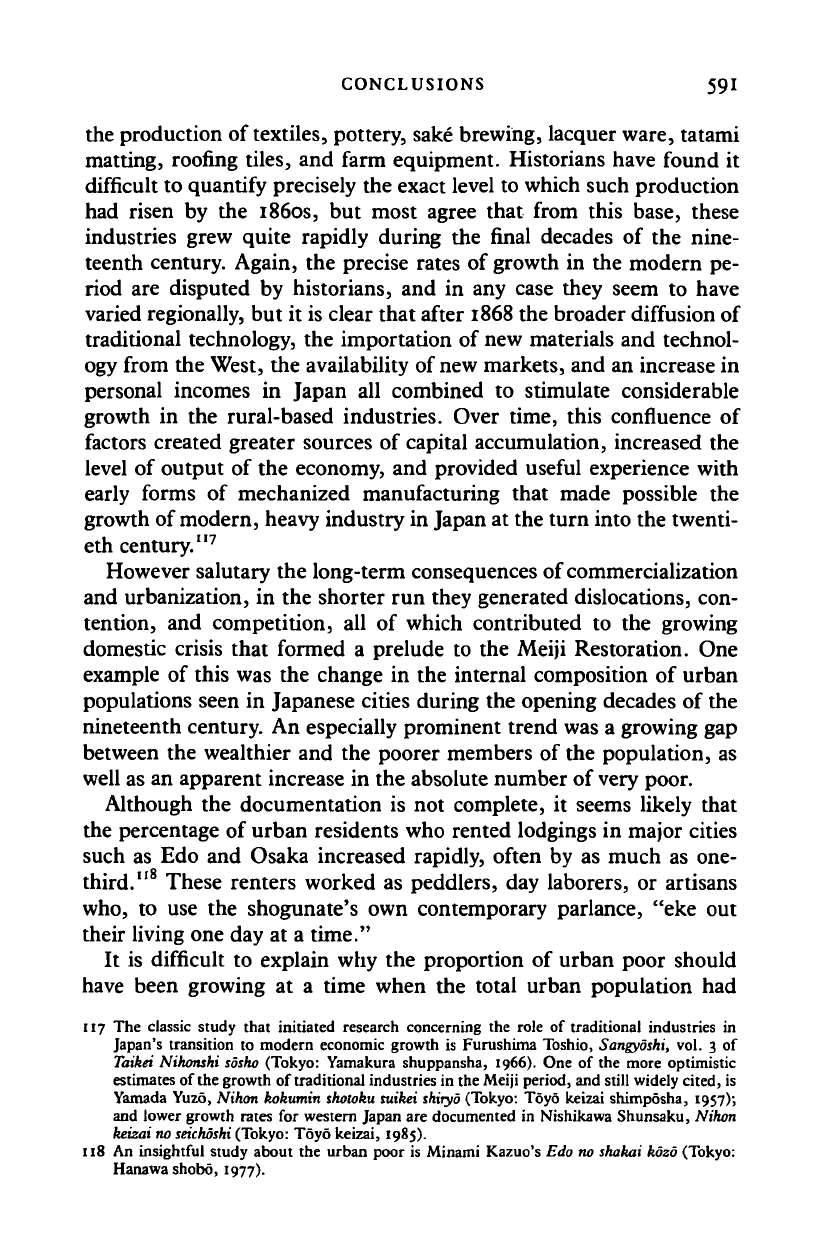
CONCLUSIONS 591
the production of
textiles,
pottery, sake brewing, lacquer ware, tatami
matting, roofing tiles, and farm equipment. Historians have found it
difficult to quantify precisely the exact level to which such production
had risen by the 1860s, but most agree that from this base, these
industries grew quite rapidly during the final decades of the nine-
teenth century. Again, the precise rates of growth in the modern pe-
riod are disputed by historians, and in any case they seem to have
varied regionally, but it is clear that after 1868 the broader diffusion of
traditional technology, the importation of new materials and technol-
ogy from the West, the availability of new markets, and an increase in
personal incomes in Japan all combined to stimulate considerable
growth in the rural-based industries. Over time, this confluence of
factors created greater sources of capital accumulation, increased the
level of output of the economy, and provided useful experience with
early forms of mechanized manufacturing that made possible the
growth of modern, heavy industry in Japan at the turn into the twenti-
eth century."
7
However salutary the long-term consequences of commercialization
and urbanization, in the shorter run they generated dislocations, con-
tention, and competition, all of which contributed to the growing
domestic crisis that formed a prelude to the Meiji Restoration. One
example of this was the change in the internal composition of urban
populations seen in Japanese cities during the opening decades of the
nineteenth century. An especially prominent trend was a growing gap
between the wealthier and the poorer members of the population, as
well as an apparent increase in the absolute number of very poor.
Although the documentation is not complete, it seems likely that
the percentage of urban residents who rented lodgings in major cities
such as Edo and Osaka increased rapidly, often by as much as one-
third."
8
These renters worked as peddlers, day laborers, or artisans
who,
to use the shogunate's own contemporary parlance, "eke out
their living one day at a time."
It is difficult to explain why the proportion of urban poor should
have been growing at a time when the total urban population had
117 The classic study that initiated research concerning the role of traditional industries in
Japan's transition to modern economic growth is Furushima Toshio, Sangyoshi, vol. 3 of
Taikei Nihonshi sosho (Tokyo: Yamakura shuppansha, 1966). One of the more optimistic
estimates of the growth of traditional industries in the Meiji period, and still widely cited, is
Yamada Yuzo, Nihon kokumin
shotoku
suikei shityo (Tokyo: Toyo keizai shimposha, 1957);
and lower growth rates for western Japan are documented in Nishikawa Shunsaku, Nikon
keizai
no seichoshi
(Tokyo: Toyo keizai, 1985).
118 An insightful study about the urban poor is Minami Kazuo's Edo no shakai kbzo (Tokyo:
Hanawa shobo, 1977).
Cambridge Histories Online © Cambridge University Press, 2008
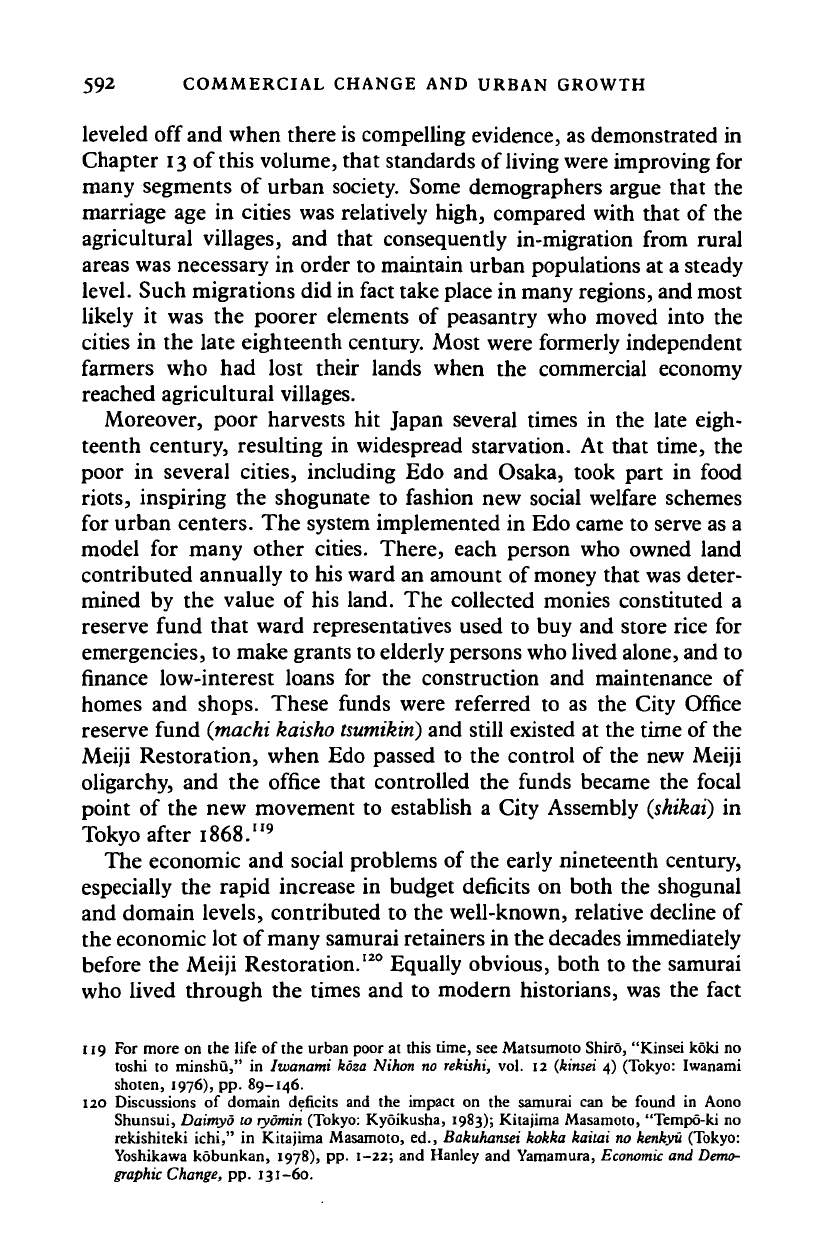
592 COMMERCIAL CHANGE AND URBAN GROWTH
leveled off and when there is compelling evidence, as demonstrated in
Chapter 13 of this volume, that standards of living were improving for
many segments of urban society. Some demographers argue that the
marriage age in cities was relatively high, compared with that of the
agricultural villages, and that consequently in-migration from rural
areas was necessary in order to maintain urban populations at a steady
level. Such migrations did in fact take place in many regions, and most
likely it was the poorer elements of peasantry who moved into the
cities in the late eighteenth century. Most were formerly independent
farmers who had lost their lands when the commercial economy
reached agricultural villages.
Moreover, poor harvests hit Japan several times in the late eigh-
teenth century, resulting in widespread starvation. At that time, the
poor in several cities, including Edo and Osaka, took part in food
riots,
inspiring the shogunate to fashion new social welfare schemes
for urban centers. The system implemented in Edo came to serve as a
model for many other cities. There, each person who owned land
contributed annually to his ward an amount of money that was deter-
mined by the value of his land. The collected monies constituted a
reserve fund that ward representatives used to buy and store rice for
emergencies, to make grants to elderly persons who lived alone, and to
finance low-interest loans for the construction and maintenance of
homes and shops. These funds were referred to as the City Office
reserve fund
(machi kaisho tsumikiri)
and still existed at the time of the
Meiji Restoration, when Edo passed to the control of the new Meiji
oligarchy, and the office that controlled the funds became the focal
point of the new movement to establish a City Assembly
(shikai)
in
Tokyo after 1868."
9
The economic and social problems of the early nineteenth century,
especially the rapid increase in budget deficits on both the shogunal
and domain levels, contributed to the well-known, relative decline of
the economic lot of many samurai retainers in the decades immediately
before the Meiji Restoration.
120
Equally obvious, both to the samurai
who lived through the times and to modern historians, was the fact
119 For more on the life of the urban poor at this time, see Matsumoto Shiro, "Kinsei koki no
toshi to minshu," in Iwanami koza Nihon no rekishi, vol. 12 (kinsei 4) (Tokyo: Iwanami
shoten, 1976), pp. 89-146.
120 Discussions of domain deficits and the impact on the samurai can be found in Aono
Shunsui, Daimyo to ryomin (Tokyo: Kyoikusha, 1983); Kitajima Masamoto, "Tempo-ki no
rekishiteki ichi," in Kitajima Masamoto, ed., Bakuhansei kokka kaitai no kenkyu (Tokyo:
Yoshikawa kobunkan, 1978), pp. 1-22; and Hanley and Yamamura,
Economic
and Demo-
graphic Change, pp. 131-60.
Cambridge Histories Online © Cambridge University Press, 2008
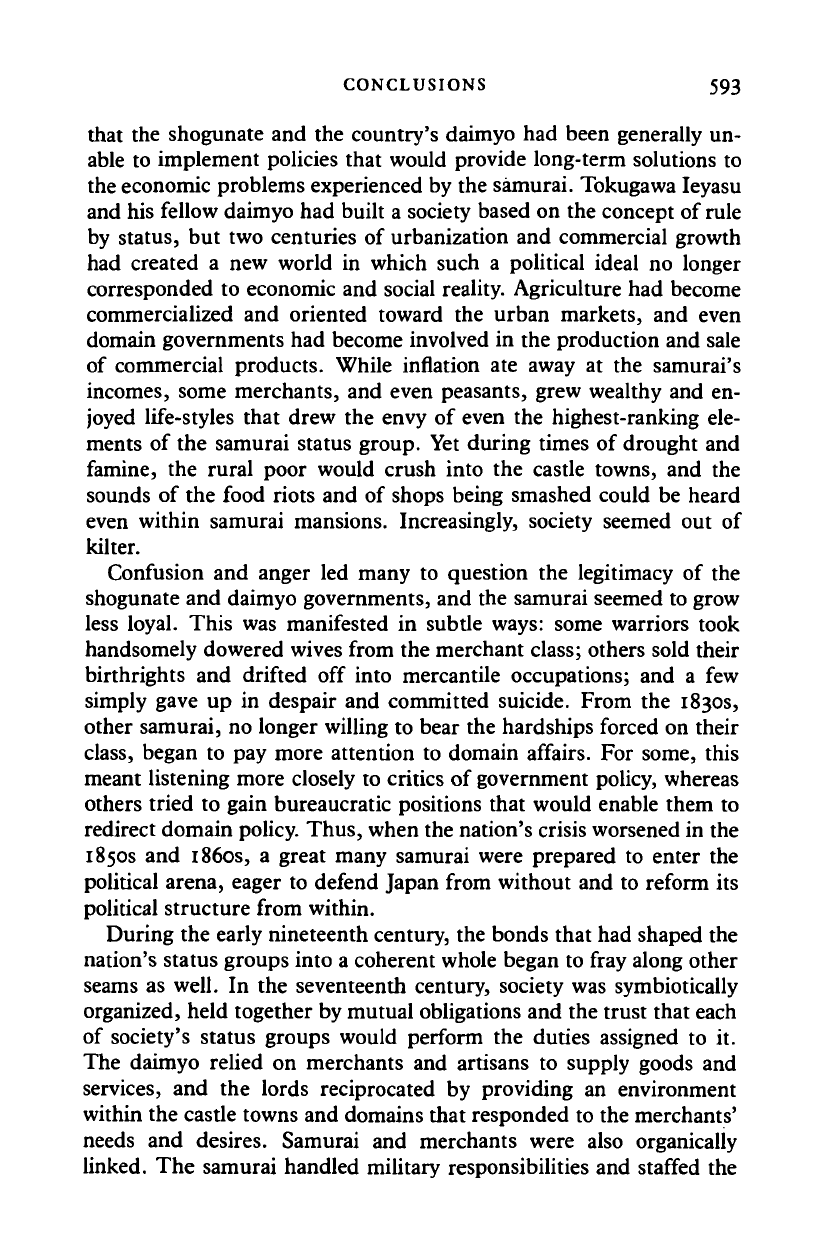
CONCLUSIONS 593
that the shogunate and the country's daimyo had been generally un-
able to implement policies that would provide long-term solutions to
the economic problems experienced by the samurai. Tokugawa Ieyasu
and his fellow daimyo had built a society based on the concept of rule
by status, but two centuries of urbanization and commercial growth
had created a new world in which such a political ideal no longer
corresponded to economic and social reality. Agriculture had become
commercialized and oriented toward the urban markets, and even
domain governments had become involved in the production and sale
of commercial products. While inflation ate away at the samurai's
incomes, some merchants, and even peasants, grew wealthy and en-
joyed life-styles that drew the envy of even the highest-ranking ele-
ments of the samurai status group. Yet during times of drought and
famine, the rural poor would crush into the castle towns, and the
sounds of the food riots and of shops being smashed could be heard
even within samurai mansions. Increasingly, society seemed out of
kilter.
Confusion and anger led many to question the legitimacy of the
shogunate and daimyo governments, and the samurai seemed to grow
less loyal. This was manifested in subtle ways: some warriors took
handsomely dowered wives from the merchant class; others sold their
birthrights and drifted off into mercantile occupations; and a few
simply gave up in despair and committed suicide. From the 1830s,
other samurai, no longer willing to bear the hardships forced on their
class,
began to pay more attention to domain affairs. For some, this
meant listening more closely to critics of government policy, whereas
others tried to gain bureaucratic positions that would enable them to
redirect domain policy. Thus, when the nation's crisis worsened in the
1850s and 1860s, a great many samurai were prepared to enter the
political arena, eager to defend Japan from without and to reform its
political structure from within.
During the early nineteenth century, the bonds that had shaped the
nation's status groups into a coherent whole began to fray along other
seams as well. In the seventeenth century, society was symbiotically
organized, held together by mutual obligations and the trust that each
of society's status groups would perform the duties assigned to it.
The daimyo relied on merchants and artisans to supply goods and
services, and the lords reciprocated by providing an environment
within the castle towns and domains that responded to the merchants'
needs and desires. Samurai and merchants were also organically
linked. The samurai handled military responsibilities and staffed the
Cambridge Histories Online © Cambridge University Press, 2008
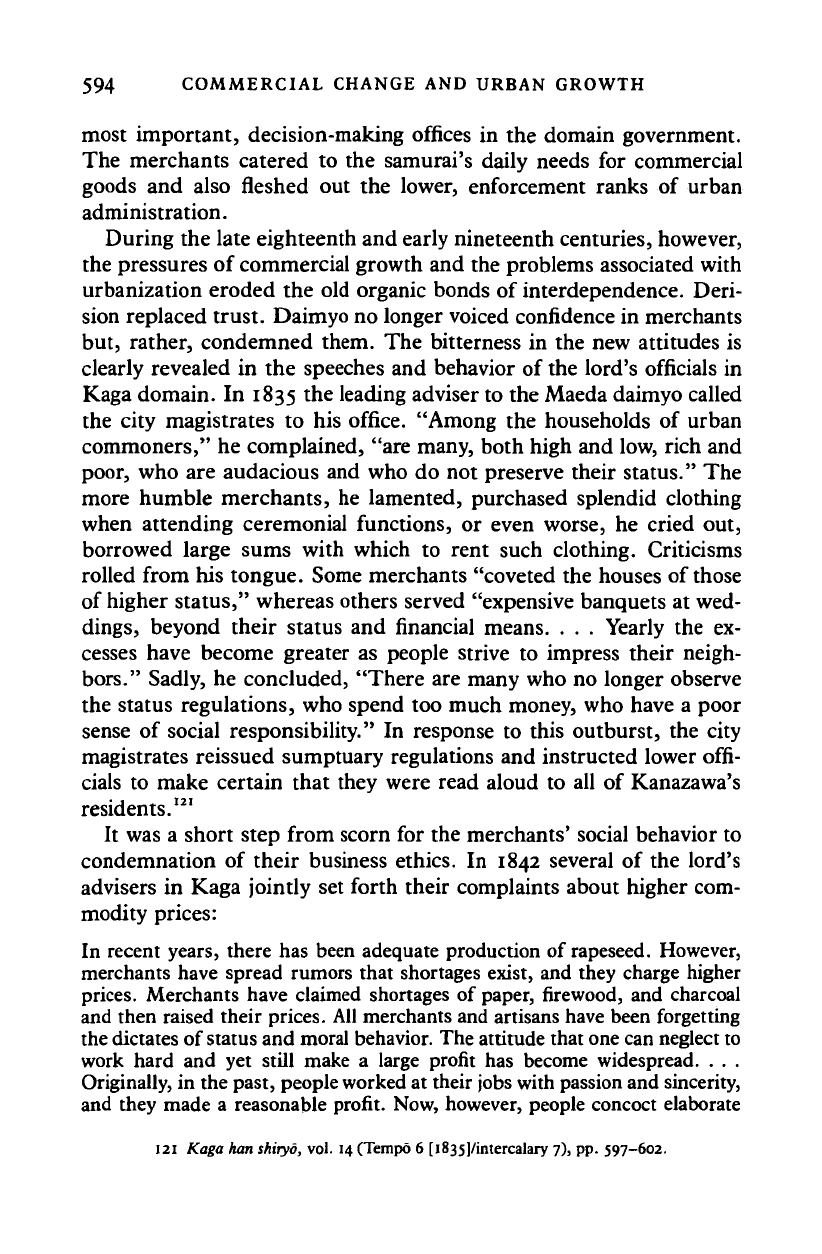
594 COMMERCIAL CHANGE AND URBAN GROWTH
most important, decision-making offices in the domain government.
The merchants catered to the samurai's daily needs for commercial
goods and also fleshed out the lower, enforcement ranks of urban
administration.
During the late eighteenth and early nineteenth centuries, however,
the pressures of commercial growth and the problems associated with
urbanization eroded the old organic bonds of interdependence. Deri-
sion replaced trust. Daimyo no longer voiced confidence in merchants
but, rather, condemned them. The bitterness in the new attitudes is
clearly revealed in the speeches and behavior of the lord's officials in
Kaga domain. In 1835 the leading adviser to the Maeda daimyo called
the city magistrates to his office. "Among the households of urban
commoners," he complained, "are many, both high and low, rich and
poor, who are audacious and who do not preserve their status." The
more humble merchants, he lamented, purchased splendid clothing
when attending ceremonial functions, or even worse, he cried out,
borrowed large sums with which to rent such clothing. Criticisms
rolled from his tongue. Some merchants "coveted the houses of those
of higher status," whereas others served "expensive banquets at wed-
dings,
beyond their status and financial means. . . . Yearly the ex-
cesses have become greater as people strive to impress their neigh-
bors."
Sadly, he concluded, "There are many who no longer observe
the status regulations, who spend too much money, who have a poor
sense of social responsibility." In response to this outburst, the city
magistrates reissued sumptuary regulations and instructed lower offi-
cials to make certain that they were read aloud to all of Kanazawa's
residents.
121
It was a short step from scorn for the merchants' social behavior to
condemnation of their business ethics. In 1842 several of the lord's
advisers in Kaga jointly set forth their complaints about higher com-
modity prices:
In recent years, there has been adequate production of rapeseed. However,
merchants have spread rumors that shortages exist, and they charge higher
prices. Merchants have claimed shortages of paper, firewood, and charcoal
and then raised their prices. All merchants and artisans have been forgetting
the dictates of status and moral behavior. The attitude that one can neglect to
work hard and yet still make a large profit has become widespread. . . .
Originally, in the past, people worked at their jobs with passion and sincerity,
and they made a reasonable profit. Now, however, people concoct elaborate
121 Kaga han shiryd, vol. 14 (Tempo 6 [l835]/imercalary 7), pp. 597-602.
Cambridge Histories Online © Cambridge University Press, 2008
